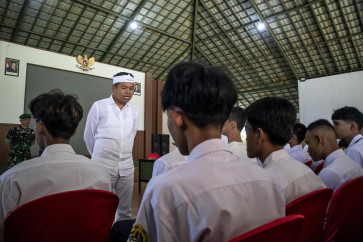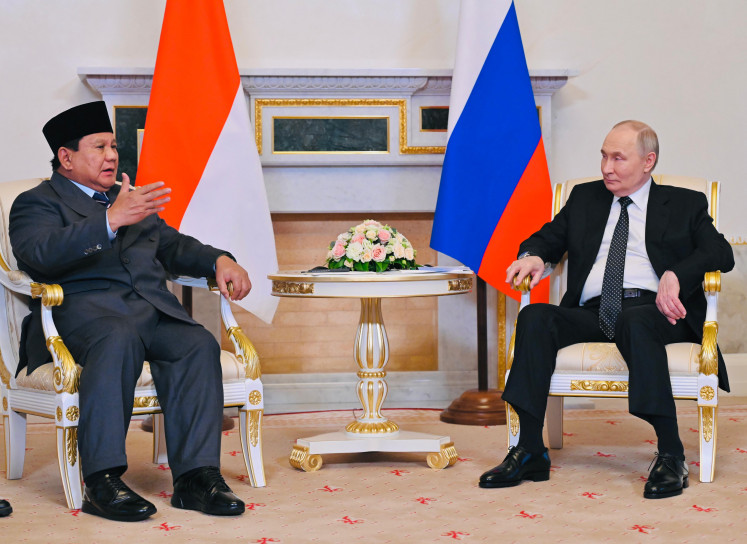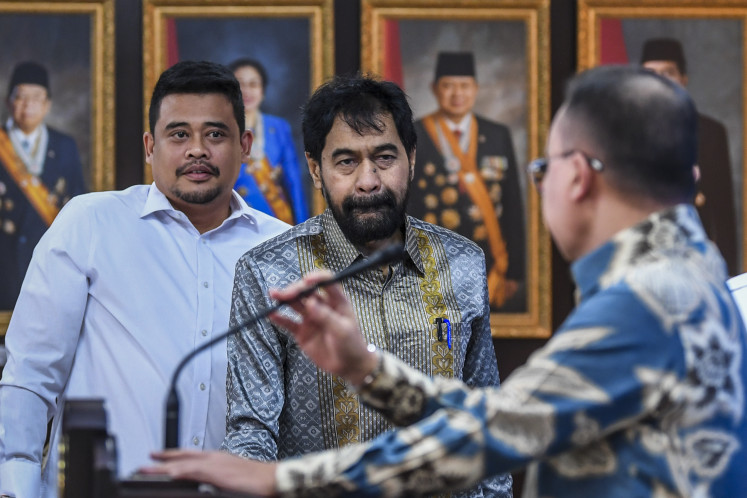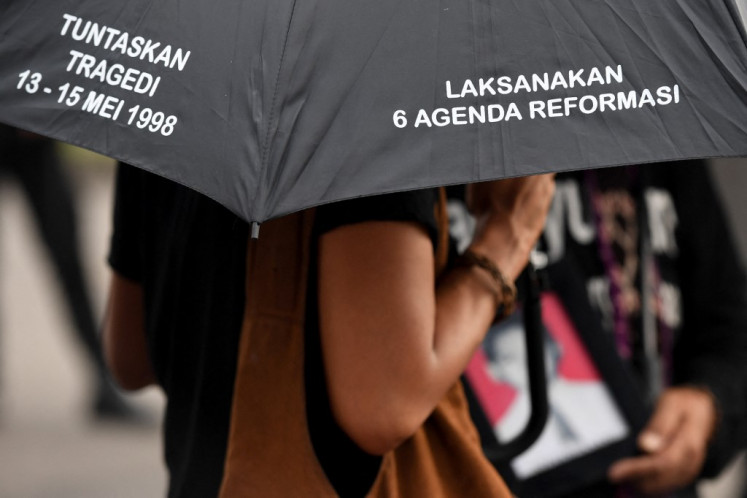Popular Reads
Top Results
Can't find what you're looking for?
View all search resultsPopular Reads
Top Results
Can't find what you're looking for?
View all search results‘Nyai’ Primal mother of the Indo-Europeans
Book talk: Writers (from left) Eka Kurniawan, Joss Wibisono and Barney Agerbeek discuss ‘The Image of the Nyai’ at the Tong Tong Fair in The Hague, the Netherlands, in June
Change text size
Gift Premium Articles
to Anyone

Book talk: Writers (from left) Eka Kurniawan, Joss Wibisono and Barney Agerbeek discuss ‘The Image of the Nyai’ at the Tong Tong Fair in The Hague, the Netherlands, in June.
Some half a million of the Netherlands’ 17 million people are of mixed Indonesian-Dutch origin. Many of these Indos, or mixed-race people, are descendants of nyai – the indigenous concubines of European men in the then Dutch East Indies. Until recently, this fact was taboo for many Indo families.
“Several times — when I was a little boy — a badly dressed Javanese woman would stand by the gate of our house. She repeatedly tried to get in contact with me, but every time our household employees would chase her away. Could she possibly be?”
Author Reggie Baay found the above text scribbled in his father’s handwriting on the back of an official document which states his grandmother’s name: “Moeinah, around 25 years of age, without a profession, living in Suarakarta-Djenkiloeng.”
Baay, 60, found the document after his father passed away in 1998. “Throughout my life, I kept asking him about his mother. He never reacted, except for one time when he vaguely spoke of a Javanese woman.”
In his extended family, the subject was avoided, with only the word “shameful” quietly uttered every now and again.

The quest for his family history culminated in his book De njai: Het Concubinaat in Nederlands-Indië (The nyai: Concubinage in the Dutch East Indies), published in 2008. Two years later, the book was translated into Indonesian with the title Nyai dan Pergundikan di Hindia Belanda.
Speaking recently in The Hague at the Tong Tong, an annual festival celebrating Indo-European culture and heritage, Baay noted that even now “I still get emails almost every day from people who recognise their own family history in my book.”
The official Indonesian dictionary describes nyai as a “term for a married or unmarried woman”, but also as “the concubine of foreigners”.
The Dutch appeared in the Indonesian archipelago in the late 16th century, first to trade but gradually also taking administrative and political control of the islands, lasting until the end of World War II. The Dutch East India Company or VOC, founded in 1602, was at the heart of the Dutch operations in Asia for two centuries, with hundreds of bases spread across the isles. Thousands of Dutch men —but very few women — started making the journey east to fill the posts needed.
“The nyai existed from the moment that VOC employees started arriving in the archipelago in the 1600s. The indigenous woman was not only the household help of the colonists, but also one who shared his bed, and often became the mother of his children,” Baay wrote.
Most nyai came from poor families, where children at a young age already had to work for a living, as household help or as laborers.
One key element in the relationship between the nyai and her European partner was inequality.
While some of the relationships within this constellation were harmonious — some men chose to marry their nyai — there was no such thing as an equal partnership between the man and the woman.
“The nyai was formally without rights. She could make no claims,” Baay explains in his book. Author Barney Agerbeek, also speaking at the Tong Tong Fair, points out that “many of them were young girls when they start working for European households, and often they did not voluntarily become nyai.”
Baay further explains that Dutch East Indies law declared that “an indigenous concubine could not demand custody of her children”, as had apparently befallen Baay’s grandmother.
The fates of the children born of these relationships varied depending on whether their father officially recognized them as his or not. Those bearing their father’s name enjoyed his legal status, with many sent off to the Netherlands for their education and to marry Europeans.
“Because of the small number of European women [in the colonies], the women of mixed heritage could climb to the upper levels of VOC society by marrying high-ranking civil servants,” said Baay.
Those not recognized by their fathers were less fortunate. As early as 1624, Baay wrote, Batavia already had an orphanage “where the residents were solely Eurasian children”.
These people of mixed Indo-European heritage formed the basis of Indo society, which numbered in the hundreds of thousands by the end of the Dutch colonial era in Indonesia. Most of them left for the Netherlands after Indonesia’s independence after World War II.
Currently, Baay estimates, over 60 percent of the 800,000 Dutch citizens with roots in Indonesia have a nyai in their lineage.
------------------------
‘Nyai’ in Literature

The nyai – the indigenous concubine of a European man in the Dutch East Indies – has been featured in Dutch, Malay and Indonesian literature for over a century.
The books’ portrayal of the nyai is often a mirror of how that society views her. In De Njai: Moeder van alle Volken (The Nyai: Mother of all People), a book of stories about nyai compiled and translated by Maya Sutedja-Liem, she points out that that the nyai in Dutch colonial literature was “used as a symbol for degeneration and decline, and undermining colonial society”.
Not so in the Malay-language literature of the same era. In books such as Nyai Dasima by the Dutch writer Gijsbert Francis and The Rose of Cikembang by Kwee Tek Hoay – both written in Malay – the nyai is characterized as “loyal, frugal and upright”, Maya writes.
Arguably, the most famous nyai in modern Indonesian literature is Nyai Ontosoroh in Pramudya Ananta Toer’s This Earth of Mankind. She is a Javanese woman who educates herself and becomes a successful businesswoman, yet falls victim to inequality within the colonial system.
Eka Kurniawan has his own interpretation of the nyai in his book Cantik itu Luka (Beauty is a Wound). The book’s main character, Dewi Ayu, is the granddaughter of a nyai who commits suicide on the day she meets her childhood sweetheart.
Speaking at the Tong Tong, Eka says that “since most history books are written from the men’s point of view, I thought it would be interesting to do it through women. However, the book is in no way a glorification of women. I just try to show how things were at that time.”
Reggie Baay had been worried that his book De njai: Het Concubinaat in Nederlands-Indië (The nyai: Concubinage in the Dutch East Indies), published in 2008, would draw criticism, but on the contrary he was overwhelmed by the positive reactions.
“The public reacted with relief, not with shame. It was finally a recognition of the truth,” he says.
When his book was published in Indonesia, he was glad that “many young Indonesians came to hear the discussions and were interested in the shared history of the two countries”. It lacked, however, the wave of emotions that his book unleashed in the Dutch Indo community.
“For the Dutch Indos, the nyai is our oermoeder [primal mother]. The long silence surrounding their existence has gripped my community for generations. I have seen my father suffer all his life, knowing that his mother was taken away from him.”
— Linawati Sidarto
Your Opinion Matters
Share your experiences, suggestions, and any issues you've encountered on The Jakarta Post. We're here to listen.
Thank you
Thank you for sharing your thoughts. We appreciate your feedback.








